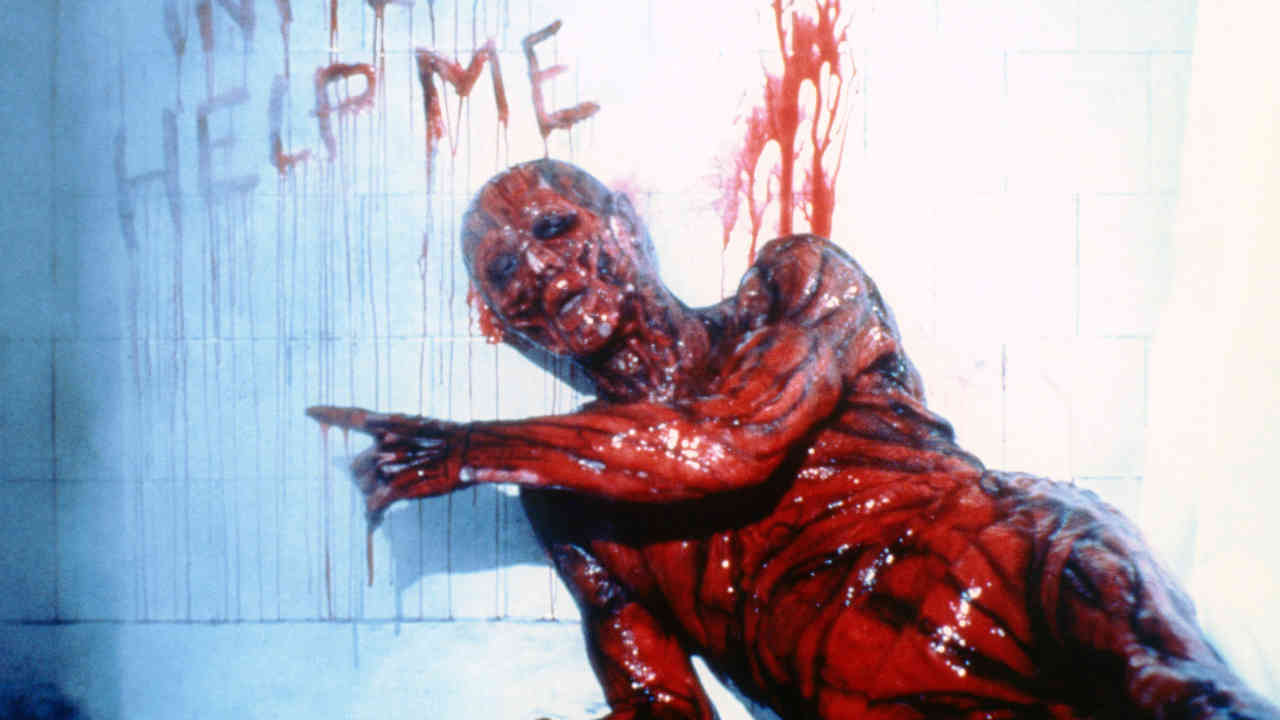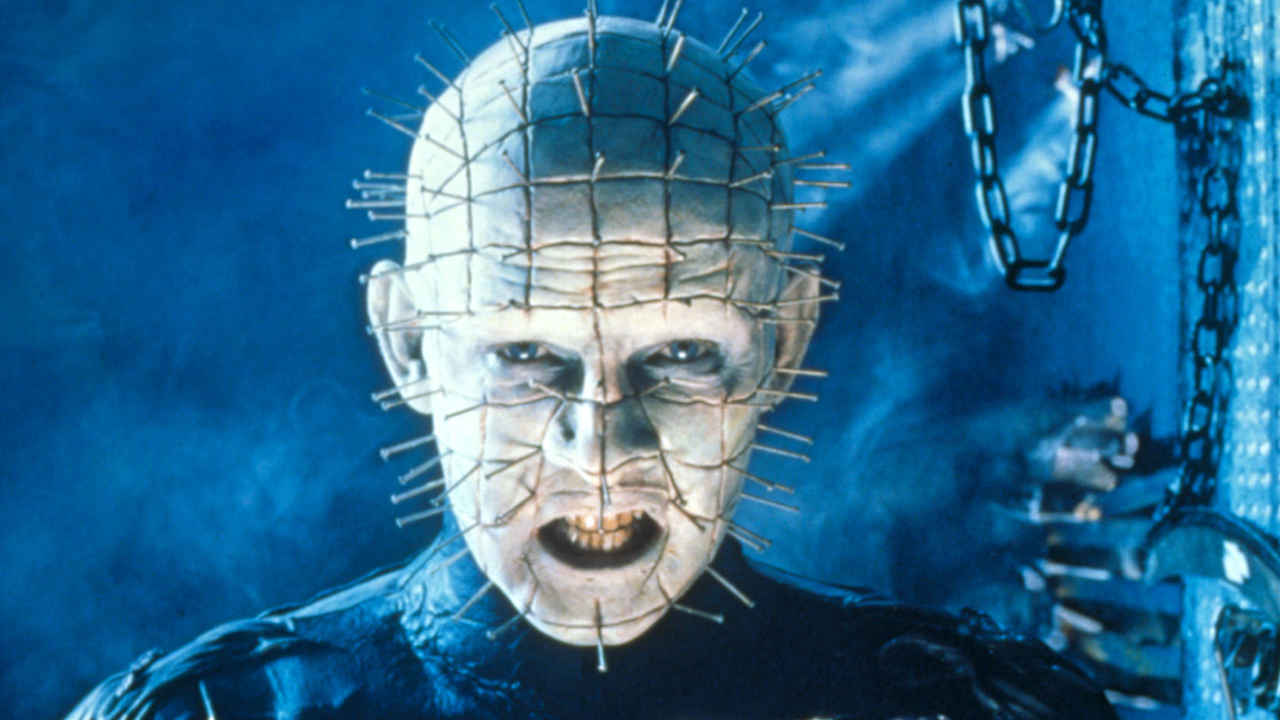It’s the autumn of 1987, and actor Doug Bradley is on the phone to his childhood friend, the author Clive Barker. They’ve just finished working together on a low-budget horror film called Hellraiser. It’s Doug’s first film role and Clive’s directorial debut. Although the actor’s part is small, his nightmarish character, Pinhead, dominates the movie’s poster.
“He was calling me from the back of a car in Los Angeles,” recalls Doug today. “He was saying, ‘Just wanted to let you know, you’re currently 30 feet high over Sunset Boulevard for your first job.’ I thought, ‘Well, that’s cool, but it’ll all be forgotten about fairly soon.’”
He couldn’t have been more wrong. A cult hit at the time, Hellraiser’s status as one of horror’s greatest and most unsettling movies has only grown in the 35 years since it was released. A nightmarish, occasionally surreal story of a man who trades his soul for “an experience beyond limits” only to be swallowed into a hellscape where he’s torn apart by demonic entities called Cenobites, it was totally different to the mainstream horror of the time.
Its interdimensional sex torture wasn’t for everybody, but it connected with those whose tastes veered towards the strange and the transgressive – not least within the metal community. In the 35 years since its release, Hellraiser’s story, visuals and aesthetics have inspired bands from Ministry to Cradle Of Filth.
“What I love about it is it has a very fairy tale element”, says Cradle of Filth frontman Dani Filth. “It’s the whole Narnia-type scenario, gone to Hell.”

As the saying goes: if you want something done right, do it yourself. Clive Barker had burst onto the horror fiction scene in the mid-80s with his short story collections, Books Of Blood. Whereas the likes of Stephen King and James Herbert were writing more traditional horror stories, the Liverpool-born author’s stories were an amalgam of dark fantasy, erotica and surrealist body horror.
Having had two of his stories, Underworld and Rawhead Rex, mangled in transition to the big screen, Clive decided that it was time he tried his hand at directing a film based on his own work.
“The only way to do this was to write the novella [The Hellbound Heart] with the specific intention of filming it,” he told Starburst magazine. “For me, [Hellraiser] was a chance to see if I could put what I felt I was putting onto the page onto the screen.”
Securing $900,000 from film company New World Pictures, Clive assembled a small cast, including Sean Chapman as the hedonistic Frank Cotton and Claire Higgins as his lover, Julia. He also called on his old friend Doug Bradley to play the lead Cenobite, officially named ‘Hell Priest’. Doug had spent several years in a theatre group with the author, and whatever the latter was working on, he was game.
“The context for me at the time was that it was another project to work with Clive,” Doug says. “For me, it was an ongoing process.”
The movie stayed relatively faithful to the original novella: the sadomasochistic Frank Cotton is sucked into a hellish dimension after summoning the demonic Cenobites with an ancient puzzle box known as the Lament Configuration, sparking murder, regeneration and a Faustian bargain with the Cenobites.
Like the story itself, Hellraiser’s aesthetics resembled nothing else in contemporary horror films. The Cenobites themselves were inspired by 70s punk, Catholic iconography and Clive’s trips to S&M clubs in New York and Amsterdam, each marred with unique deformities and elaborate scarification, ranging from excised throats to mouths pulled open with hooks.
Doug Bradley’s own iconic make-up took six hours to create. The novella describes the Hell Priest as a being of indeterminate gender, “tattooed with an intricate grid” across their head and face, with jewelled pins driven down to the bone at each intersection. Doug’s blue eyes were covered with glassy black contact lenses to remove any trace of humanity and his skin was transformed to the mottled white of a corpse.
Before his first screen test, Doug spent 20 minutes alone in his dressing room, staring into a mirror and trying to make sense of his unrecognisable face. Once on set, he was repeatedly given the same note from an excited Clive: do less.
“If you keep on being told ‘do less’, you wind up where you feel like you’re just standing on your marks, not emoting anything and just speaking words,” says Doug of his cold, inscrutable performance. “And really what Clive was saying to me was, ‘Do exactly that’, because the makeup is working overtime on your behalf. The more you don’t sell it, the more you’re selling it.”
Clive approached experimental industrial/electronic duo Coil to create the soundtrack, confident their disturbing music would match the mood of the movie. Coil proceeded to record a demo, but the studio overruled the director, opting for a soundtrack by horror movie composer Christopher Young instead.
“The soundtrack bought the film to life,” recalls Dani Filth. “It has this dark, rich, sort of fairy-tale tapestry to it.”
When Hellraiser opened in September 1987, critics were divided. Some panned it as explicit trash and others saw it as the herald of a new age of horror. It refused to conform to the campy, comedy-edged frights of Evil Dead II and A Nightmare On Elm Street 3, both released the same year. Hellraiser was a collision of the profane and the sacred, the mundane and the fantastical, suggesting extreme pleasure might be indistinguishable from pain.
Doug Bradley’s character – dubbed ‘Pinhead’ on account of his extreme acupuncture chic – was an instant hit. While he only appeared in the movie for a total of eight minutes, it was Pinhead who appeared on the movie poster above the tagline ‘He’ll tear your soul apart.’
“I’ve always said that the image [of Pinhead] is an image of received pain,” says Doug. “‘Look what was done to me’ or ‘Look what I did to myself’… ‘Now imagine what I could do to you.’”
Hellraiser grossed $14.5 million at the box office, which was seriously impressive considering its meagre budget. It gained a wider cult following after its release on VHS video. That’s how a 14-year-old Dani Filth saw came across it.
“My friend’s dad had a video shop in our village, and he managed to get an advanced copy of it,” says Dani. “I’m ashamed to admit it, but a few of my friends stole it out of his bag so we could watch it. We watched it round my friend’s house, and even though I was a real horror movie buff back then, I think it shocked us. There were so many disturbing scenes.”
One of the most disturbing scenes comes when Frank Cotton is resurrected from the Cenobite hell, pulling himself half-formed out of the floorboards; he’s later recaptured by the Cenobites and torn apart by hooks while wearing his brother’s skin as a suit.
“Barker’s work is a rich tapestry of dark fantasy. The supposition between sex and death, Eros and Thanatos, and love/hate,” says Dani Filth. “I think Hellraiser is a very strong metaphor for death as well, because no one has come back from the other side of the doorway, so there is that mystery.”
Hellraiser’s bloody fingerprints began to appear on the music scene soon after its release. Canadian industrial outfit Skinny Puppy used a sample from the film on their 1989 track Fascist Jock Itch, with Ministry, White Zombie and Entombed following suit. The movie didn’t just bleed into the music either – its influence was visual, too.
“When I had my first leather costume made, it was like, ‘Yeah, just look at the Cenobites, I want something like that!’” admits Dani. “And this was back in ’97.”
Cradle Of Filth aren’t the only band to draw on Hellraiser’s aesthetic. Dimmu Borgir channelled the Cenobites’ fetishistic, chain-swinging, leather-clad look onstage and on album covers – the female-torso-bound-in-barbed-wire image on 2001’s Puritanical Euphoric Misanthropia album is very Clive Barker, while the song Hybrid Stigmata from that record borrows lines from Hellraiser for good measure. Similarly, Meshuggah’s video for their 2008 track Bleed drew inspiration from the movie, and the Swedish band released their own limited edition Hellraiser merch at 2017’s San Diego Comic-Con.
It hasn’t just been one-way traffic, either. Motörhead contributed the song Hellraiser (originally written by Lemmy for Ozzy Osbourne) to 1992’s ‘threequel’ Hellraiser III: Hell On Earth, even enlisting Doug Bradley to appear in the music video in full Pinhead regalia, playing poker with Lemmy. Doug himself has become an honorary member of the metal community, contributing vocals to several Cradle Of Filth songs, including Her Ghost In The Fog and Mother Of Abominations.
“Doug has got a very imperious voice and it’s very synonymous straight away,” says Dani. “He’s terrifying, almost comforting as well. And that marriage of extremes with his voice and his performance… it’s very dominating.”
In the wake of Hellraiser’s cult success, New World Pictures greenlit a sequel, triggering a franchise that currently stands at 11 films. Fan consensus is that the subsequent movies started off strong but became progressively worse. “I’ve watched most of them, and the more that Doug got filtered out until eventually he was replaced kinda turned me off,” says Dani.
A Hellraiser reboot is airing on US streaming service Hulu this month, with Clive Barker onboard as producer and actress Jamie Clayton as the new Pinhead. Dani predicts that a new generation of musicians will find inspiration in it.
“There’s a lot of bands fronted by women, so I should imagine it will translate into that area,” Dani says of the updated Pinhead. “There’s a band called Sick N’ Beautiful, and they have a very over-the-top aesthetic about them. I could see it translate into their image, or a band such as Jinjer.”
Pinhead and the Cenobites remain the key to Hellraiser’s lasting legacy. Their mystique and cold majesty give them an inescapable gravitas that has enthralled and inspired subsequent generations of horror fans and musicians alike.
“I’ve always said you can take the Cenobites out of that story completely. Forget they exist, and you have a serviceable slasher movie,” says Doug. “Then Clive takes a grain of pure gothic horror, and into the middle of this urban slasher movie, he just drops ‘the things in the attic’ and boom! Everything opens up.”
It’s that grain of pure gothic horror, that flirtation with the bizarre and the fantastical, that makes Hellraiser so unforgettable. Like the fairy tales that take us into hidden worlds, so Hellraiser’s dark, depraved story remains eternally captivating. Once the ancient puzzle box is opened, there is no going back.
The new Hellraiser movie is streaming now on Hulu
